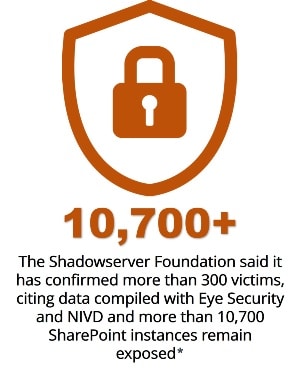
SharePoint zero trust security is critical for defending against zero-day vulnerabilities and access control weaknesses. By combining FileFlex with a Zero Trust Application Access solution like Illumio, organizations can eliminate direct exposure, enforce granular access, and secure SharePoint without replacing it.
SharePoint Under Siege: Why Zero Trust Access Is Now Critical
Estimated reading time: 5 minutes
Table of Contents
-
- Introduction: SharePoint Zero Trust Security to Defend Against Zero-Day Vulnerabilities
- Critical zero-day vulnerability campaign hits Microsoft SharePoint
- The Evolution of the Recent SharePoint Attacks
- Why SharePoint Zero Trust Security Is Now Essential
- Why Using FileFlex and ZTAA to Enforce SharePoint Zero Trust Security is Essential
- Key Takeaways
- Conclusion: Assume Compromise and Respond with SharePoint Zero Trust Security
Introduction: SharePoint Zero Trust Security to Defend Against Zero-Day Vulnerabilities

Critical zero-day vulnerability campaign hits Microsoft SharePoint
A critical zero-day vulnerability campaign targeting Microsoft SharePoint, known as ToolShell, is actively exploiting two new flaws—CVE-2025-53770 (remote code execution) and CVE-2025-53771 (authentication bypass)—to compromise on-premises SharePoint servers worldwide. Linked to Chinese state-affiliated threat groups like Linen Typhoon and Storm-2603, the campaign has affected hundreds of systems across government, healthcare, energy, and education sectors, with over 10,000 servers still exposed.
This SharePoint vulnerability campaign directly relates to improper authentication, access control bypass, and catalog exploitation, exposing critical risks in enterprise environments. Specifically, CVE-2025-53771 allows attackers to spoof authentication and bypass access controls, enabling unauthorized access to SharePoint sites without valid credentials. Once inside, CVE-2025-53770 facilitates remote code execution through insecure deserialization, letting attackers deploy webshells and take full control of servers. The attackers then exploit internal SharePoint catalogs (such as ToolPane.aspx) to escalate privileges, move laterally, and plant persistent backdoors. These flaws highlight how SharePoint’s complex permissions model and public-facing architecture can become high-risk attack surfaces when not properly segmented or monitored.
The Evolution of the Recent SharePoint Attacks
| Phase | Timeline | Activity |
| Initial exploit chain | July 7–14, 2025 | ToolShell weaknesses (49704/49706) detected |
| Bypass zero‑days active | July 18–19 | CVE‑53770/53771 used to deploy ToolShell webshells |
| Widespread compromise | July 20–24 | Hundreds of global on‑prem servers compromised |
| Shift to ransomware | July 18 onward | Storm‑2603 deploys Warlock ransomware |
For enterprises, the campaign underscores the urgent need for Zero Trust principles, strict access controls, real-time monitoring, and segregation of SharePoint systems from broader network infrastructure to mitigate the risk of systemic compromise.
Why SharePoint Zero Trust Security Is Now Essential
When used together, FileFlex Enterprise and a Zero Trust Application Access (ZTAA) solution like Illumio form a powerful strategic overlay that directly addresses the security weaknesses exposed in the recent SharePoint vulnerabilities, without replacing SharePoint itself. Instead, they work in tandem to govern and secure how data is accessed, shared, and monitored across SharePoint and beyond.
In this architecture, ZTAA is used to enforce policy-based segmentation and microperimeter controls, ensuring that all access to SharePoint repositories is routed exclusively through FileFlex. FileFlex then applies Zero Trust Data Access (ZTDA) principles to authenticate users, verify device posture, enforce granular permissions, log all activity, and prevent data sprawl—even across hybrid or on-prem environments.

Why Using FileFlex and ZTAA to Enforce SharePoint Zero Trust Security is Essential
-
Enforces a Zero Trust Access Control Layer to eliminate direct access to SharePoint repositories
-
-
- By forcing all access to SharePoint through FileFlex, organizations can prevent both internal and external actors from connecting directly to vulnerable SharePoint endpoints. ZTAA enforces network segmentation policies that allow only the FileFlex connector to communicate with SharePoint repositories, closing off direct IP-level access. This effectively removes SharePoint from the exposed attack surface and contains potential threats within tightly defined microsegments, blocking lateral movement and unauthorized discovery.
-
-
Enforces least-privilege access and contextual authorization
-
- FileFlex applies strict Zero Trust Data Access controls to each user session, granting access based on a combination of user identity and role. This ensures users receive only the minimum necessary access to data stored in SharePoint. Even if credentials are compromised, FileFlex blocks unauthorized or high-risk access attempts that fall outside defined policies, preventing privilege escalation and misuse of stolen accounts.
-
-
Monitors, logs, and audits all file activity in real time
-
- Every file interaction—whether it involves accessing, sharing, editing, or downloading content—is tracked by FileFlex and logged. This visibility includes user identity, device used, and time stamps, providing a full audit trail. Unlike native SharePoint logs, which can be fragmented or insufficient, FileFlex delivers consolidated, real-time oversight that supports threat detection, incident response, and compliance requirements.
-
-
Extends Zero Trust to SharePoint and beyond
-
- Because FileFlex is storage-agnostic, it provides the same security model not only for SharePoint but also for other file repositories such as file servers, NAS, and cloud storage. This unified control framework helps prevent inconsistent security practices across different platforms, reducing the risk of data sprawl and shadow IT. Organizations can apply uniform data governance policies across all unstructured data, regardless of where it resides.
-
-
Modernizes legacy SharePoint environments without data migration
- FileFlex overlays modern Zero Trust capabilities onto existing SharePoint infrastructure, eliminating the need to migrate files to the cloud or rearchitect workflows. Organizations retain full control over data residency and architecture while gaining cloud-like security, governance, and usability. This enables enterprises to modernize their security posture in a practical, non-disruptive way, making legacy systems Zero Trust-ready without the cost and complexity of replacement.
Key Takeaways
| Risk Without FileFlex | FileFlex Protection |
| Native SharePoint auth vulnerabilities | Enforced Zero Trust overlay |
| Direct SharePoint exposure to users | Access via FileFlex broker layer |
| Over-permissioned links and shares | Granular, expiring, non-anonymous access |
| Delayed or missing audit logs | Real-time, file-level access telemetry |
| Attack pivot across connected storage | Unified governance of all file access |
Conclusion: Assume Compromise and Respond with SharePoint Zero Trust Security
With recent critical vulnerabilities in SharePoint, organizations must assume compromise and move to Zero Trust for file access. When used together with a ZTAA product, FileFlex provides a seamless, agentless overlay that secures access to SharePoint and all other data sources—even if native controls fail. It eliminates direct exposure, applies granular policy enforcement, and delivers real-time telemetry to stop insider threats, misconfigurations, and zero-day exploits before they spread.
For more information on using FileFlex to complement SharePoint see 19 Reasons Why Zero Trust Data Access is an Essential SharePoint Add-in, Why Microsoft-Centric Security Isn’t Enough: The Case for Zero Trust Data Access, and Accelerating Digital Transformation Leveraging Zero Trust Data Access (ZTDA) in a Microsoft Ecosystem.
Frequently Asked Questions
What is SharePoint zero trust security?
SharePoint zero trust security is a strategy that enforces strict access controls, continuous user verification, and real-time monitoring to protect SharePoint environments from unauthorized access and zero-day vulnerabilities.
How do zero-day vulnerabilities affect SharePoint?
Zero-day vulnerabilities in SharePoint can allow attackers to bypass authentication, execute malicious code, and gain persistent access, putting sensitive enterprise data and systems at risk.
How does FileFlex enhance SharePoint zero trust security?
FileFlex acts as a secure access broker that enforces least-privilege access, authenticates users and devices, monitors all file activity, and prevents direct exposure of SharePoint repositories.
Why combine FileFlex with a Zero Trust Application Access solution like Illumio?
Using FileFlex alongside Illumio’s policy-based segmentation ensures that all SharePoint access is routed securely, blocking unauthorized paths, and providing comprehensive governance across the entire data environment.